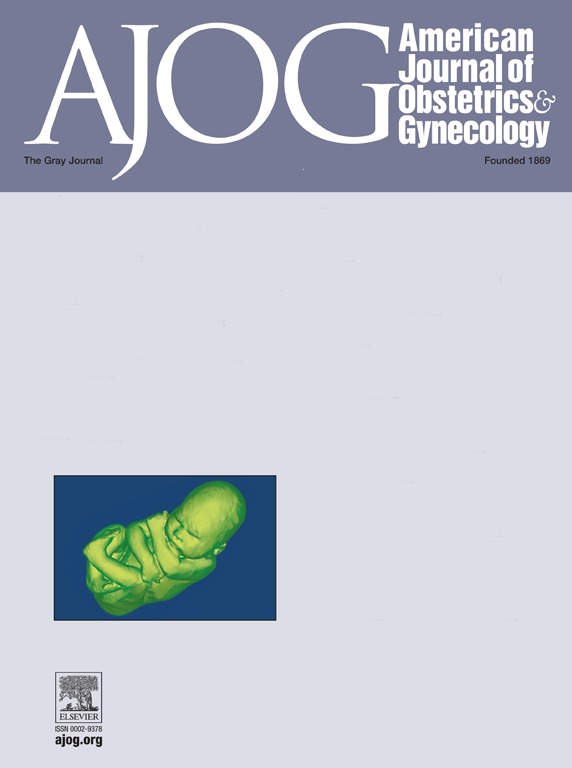Insights from preventability assessments across 42 state and city maternal mortality reviews in the United States
IF 8.7
1区 医学
Q1 OBSTETRICS & GYNECOLOGY
引用次数: 0
Abstract
Background
The rising trend in maternal mortality over the past 3 decades sets the United States apart from all other high-income countries. Multidisciplinary state and city Maternal Mortality Review Committees conduct comprehensive reviews of maternal deaths, including assessments of preventability and contributing factors.
Objective
Assess preventability of and contributing factors to maternal mortality in the U.S.
Study Design
This study is a secondary analysis of cross-sectional, population-based data from the most recent, publicly available Maternal Mortality Review Committee data from 40 state and 2 cities in the U.S. Preventability were analyzed among all deaths during pregnancy or within 1 year postpartum from any cause (pregnancy-associated deaths) and deaths during pregnancy or within 1 year postpartum from causes related to pregnancy or its management, but not from accidental causes (pregnancy-related deaths). We also explored preventability by cause-of-death and contributing factors grouped as community, patient-family, provider, facility, and health system factors.
Results
Of deaths that occurred after 2010, between 53% to 93.8% of pregnancy-associated deaths and 45% to 100% of pregnancy-related deaths were deemed preventable across the 42 states and cities. Across the 10 states reporting pregnancy-related death preventability by cause-of-death, Maternal Mortality Review Committees deemed preventable >90% of deaths from preeclampsia-eclampsia and mental health conditions, >80% of deaths from hemorrhage and cardiovascular conditions, about 70% of deaths from infection and thrombotic embolism, and about 40% of deaths from amniotic fluid embolism and stroke. A total of 3345 contributing factors were described in Maternal Mortality Review Committee reports from 14 states in relation to 739 pregnancy-related deaths. While collectively patient-family and provider factors were most frequently noted as contributing to pregnancy-related deaths, the contribution of such factors varied between 6% to 56% and 18% to 42.3%, respectively, across the states. Based on data from 20 Maternal Mortality Review Committees with available information, racism or discrimination were noted in relation to 37.7% of pregnancy-related deaths.
Conclusion
A large proportion of pregnancy-associated deaths and pregnancy-related deaths in the U.S. are preventable. However, likely due to differences in Maternal Mortality Review Committee membership, available data, and judgement employed to determine preventability, wide variation exists in the proportion of deaths deemed preventable and factors identified as contributing to such deaths across states. There is need to reevaluate the definitions, structure, and outputs for maternal death preventability assessments currently employed by a majority Maternal Mortality Review Committees to adequately inform state and national programming and policies.
从美国 42 个州和市的孕产妇死亡率评估中获得的启示。
背景:过去三十年来,孕产妇死亡率呈上升趋势,这使美国有别于所有其他高收入国家。多学科的州和市孕产妇死亡率审查委员会(MMRCs)对孕产妇死亡进行全面审查,包括评估可预防性和促成因素:研究设计:本研究对来自美国 40 个州和 2 个城市的 MMRC 最新公开数据中的横断面人口数据进行了二次分析。我们分析了所有妊娠期或产后一年内因任何原因导致的死亡(与妊娠相关的死亡,PAD),以及妊娠期或产后一年内因与妊娠或妊娠管理相关的原因而非意外原因导致的死亡(与妊娠相关的死亡,PRD)的可预防性。我们还根据死因以及社区、患者-家庭、医疗服务提供者、医疗设施和医疗系统等因素探讨了可预防性:结果:在 2010 年之后发生的死亡案例中,42 个州和城市中有 53%-93.8% 的 PAD 和 45%-100% 的 PRD 被认为是可预防的。在按死因报告PRD可预防性的10个州中,MMRCs认为90%以上的子痫前期-子痫和精神健康状况导致的死亡、80%以上的出血和心血管状况导致的死亡、约70%的感染和血栓栓塞导致的死亡以及约40%的羊水栓塞和中风导致的死亡是可以预防的。来自14个州的MMRC报告共描述了3345个导致739例PRD的因素。虽然患者-家庭和医疗服务提供者因素是导致PRD最常见的因素,但这些因素在各州的比例分别为6%-56%和18%-42.3%。根据 20 个提供信息的 MMRC 的数据,37.7% 的 PRDs 与种族主义或歧视有关:结论:在美国,很大一部分 PAD 和 PRD 是可以预防的。然而,可能由于MMRC成员、可用数据和判断可预防性的方法不同,各州被认为可预防的死亡比例和导致此类死亡的因素存在很大差异。有必要重新评估大多数孕产妇和新生儿资源中心目前采用的孕产妇死亡可预防性评估的定义、结构和产出,以便为各州和国家的计划和政策提供充分信息。
本文章由计算机程序翻译,如有差异,请以英文原文为准。
求助全文
约1分钟内获得全文
求助全文
来源期刊
CiteScore
15.90
自引率
7.10%
发文量
2237
审稿时长
47 days
期刊介绍:
The American Journal of Obstetrics and Gynecology, known as "The Gray Journal," covers the entire spectrum of Obstetrics and Gynecology. It aims to publish original research (clinical and translational), reviews, opinions, video clips, podcasts, and interviews that contribute to understanding health and disease and have the potential to impact the practice of women's healthcare.
Focus Areas:
Diagnosis, Treatment, Prediction, and Prevention: The journal focuses on research related to the diagnosis, treatment, prediction, and prevention of obstetrical and gynecological disorders.
Biology of Reproduction: AJOG publishes work on the biology of reproduction, including studies on reproductive physiology and mechanisms of obstetrical and gynecological diseases.
Content Types:
Original Research: Clinical and translational research articles.
Reviews: Comprehensive reviews providing insights into various aspects of obstetrics and gynecology.
Opinions: Perspectives and opinions on important topics in the field.
Multimedia Content: Video clips, podcasts, and interviews.
Peer Review Process:
All submissions undergo a rigorous peer review process to ensure quality and relevance to the field of obstetrics and gynecology.

 求助内容:
求助内容: 应助结果提醒方式:
应助结果提醒方式:


